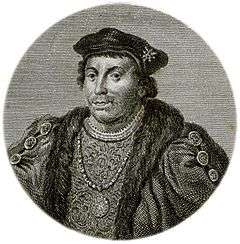Henry Stafford, 2nd Duke of Buckingham
| The Duke of Buckingham | |
|---|---|
|
An 18th century illustration of Henry Stafford | |
| Spouse(s) | Catherine Woodville |
|
Issue
Edward Stafford, 3rd Duke of Buckingham Elizabeth Stafford Henry Stafford, 1st Earl of Wiltshire Anne Stafford Humphrey Stafford Margaret Stafford | |
| Father | Humphrey Stafford, Earl of Stafford |
| Mother | Margaret Beaufort, Countess of Stafford |
| Died | 2 November 1483 (aged 28) |

Henry Stafford, 2nd Duke of Buckingham, KG (4 September 1454 – 2 November 1483) was an English nobleman known as the namesake of Buckingham's rebellion, a failed but significant collection of uprisings in England and parts of Wales against Richard III of England in October 1483. He is also one of the primary suspects in the disappearance (and presumed murder) of the Princes in the Tower.
Life
The son of Humphrey Stafford, Earl of Stafford and Margaret Beaufort, Countess of Stafford, Buckingham became Earl of Stafford in 1458 at age 4 upon his father's death, and was made a ward of King Edward IV of England. He became the Duke of Buckingham in 1460 following the death of his grandfather, Humphrey Stafford, 1st Duke of Buckingham. In February 1466 he was married to Catherine Woodville, sister of Edward IV's queen, Elizabeth Woodville, and daughter to Richard Woodville, 1st Earl Rivers.[1] Buckingham and his wife had four children:
- Edward Stafford, 3rd Duke of Buckingham (3 February 1478 – 17 May 1521)
- Elizabeth Stafford, Countess of Sussex (ca. 1479 – 11 May 1532)
- Henry Stafford, 3rd Earl of Wiltshire (c. 1479 – 6 April 1523)
- Anne Stafford, Countess of Huntingdon (c. 1483–1544)
Upon the death of Edward IV in 1483, Buckingham allied himself to the king's younger brother Richard, Duke of Gloucester, helping him succeed to the throne as Richard III in lieu of Edward's living sons. Becoming disaffected with Richard, Buckingham then joined with Henry Tudor and Tudor's mother, Margaret Beaufort, leading an unsuccessful rebellion in his name. Buckingham was executed for treason by Richard on 2 November 1483: he was beheaded in Salisbury market-place. He is believed to have been buried in St Peter's Church in Britford in Wiltshire.[1]
Buckingham's precise motivation has been called "obscure"; he had been treated well by Richard.[2] The traditional naming of the rebellion after him has been labelled a misnomer, with John Morton and Reginald Bray more plausible leaders.[3]
Buckingham is also one of the primary suspects in the disappearance (and presumed murder) of the Princes in the Tower, Edward IV's young sons Edward V of England and Richard of Shrewsbury, Duke of York.
In fiction
Buckingham is among the major characters featured in William Shakespeare's play Richard III, which portrays him as a man openly allying with Richard III in his schemes—until he is ordered to kill the Princes in the Tower.
Buckingham is depicted as a supporting character in Philippa Gregory's 2009 historical novel The White Queen (2009). He is depicted as the murderer of the Princes in the Tower in Sharon Penman's 1982 debut novel The Sunne in Splendour.
References
- 1 2
 "Stafford, Henry (1454?-1483)". Dictionary of National Biography. London: Smith, Elder & Co. 1885–1900.
"Stafford, Henry (1454?-1483)". Dictionary of National Biography. London: Smith, Elder & Co. 1885–1900. - ↑ Carpenter, Christine (13 November 1997). The Wars of the Roses: Politics and the Constitution in England, C.1437-1509. Cambridge University Press. p. 212. ISBN 978-0-521-31874-7. Retrieved 5 April 2013.
- ↑ Fritze, Ronald H.; Baxter Robison, William (2002). Historical dictionary of late medieval England, 1272-1485. Greenwood Publishing Group. p. 77. ISBN 978-0-313-29124-1. Retrieved 5 April 2013.
External links
| Wikisource has the text of the 1911 Encyclopædia Britannica article Buckingham, Henry Stafford, 2nd Duke of. |
| Honorary titles | ||
|---|---|---|
| Preceded by Richard, Duke of Gloucester |
Lord High Constable 1483 |
Succeeded by Lord Thomas Stanley |
| Peerage of England | ||
| Preceded by Humphrey Stafford |
Duke of Buckingham 1460–1483 |
Succeeded by Forfeit (restored in 1485 for Edward Stafford) |
